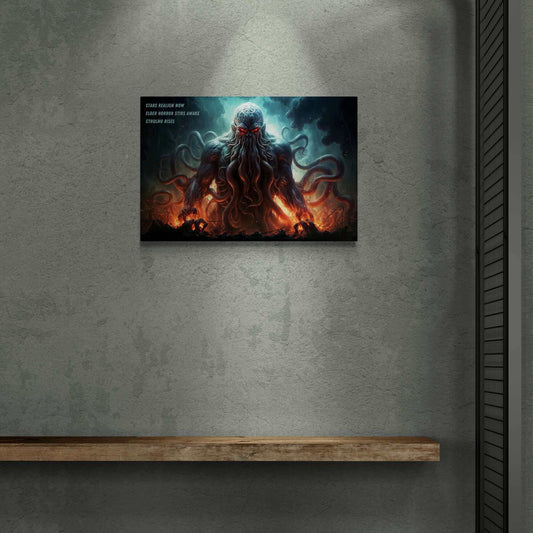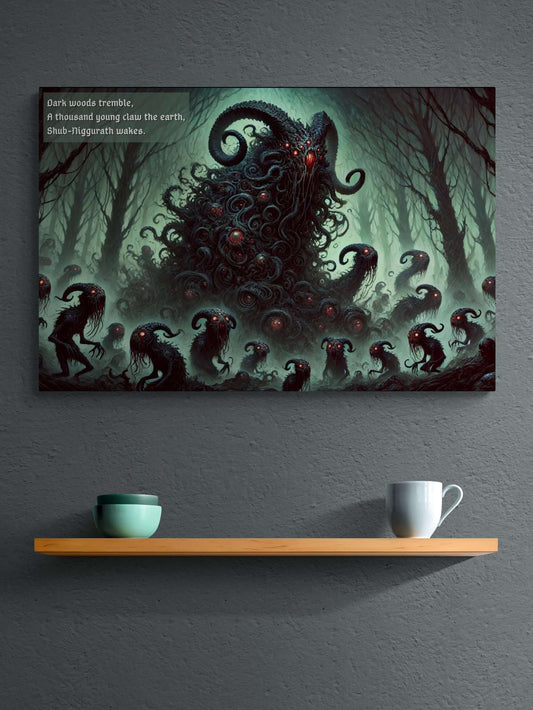Collection: Cthulhu
Cthulhu Wall Art: Lovecraftian Collection | Cosmic Horror Prints
Immerse yourself in the eerie world of H.P. Lovecraft with our exclusive Cthulhu wall art collection. These striking prints bring cosmic horror to life, transforming your space into a portal to the unknown.
Each piece in our Lovecraftian collection captures the essence of cosmic dread, from Cthulhu's tentacled visage to the impossible geometry of sunken R'lyeh.
Elevate your interior design with a touch of the bizarre. Order now and let the Great Old Ones watch over your walls!

-
Come Play With Me: Macabre Lovecraftian Canvas Wall Art with Haunting 2-Sentence Horror Story
Regular price From $44.90Regular priceUnit price / per -
Come Play With Me: Macabre Lovecraftian Poster Wall Art with Haunting 2-Sentence Horror Story
Regular price From $21.90Regular priceUnit price / per -
Cosmic Chaos: Mesmerizing Azathoth Limerick-Inspired Canvas Wall Art
Regular price From $44.90Regular priceUnit price / per -
Cosmic Chaos: Mesmerizing Azathoth Limerick-Inspired Poster Wall Art
Regular price From $21.90Regular priceUnit price / per -
Cosmic Enigma: Ethereal Yog-Sothoth Canvas Wall Art
Regular price From $44.90Regular priceUnit price / per -
Cosmic Enigma: Ethereal Yog-Sothoth Poster Wall Art
Regular price From $21.90Regular priceUnit price / per -
Cosmic Horror Awakening: Lovecraftian Apocalypse with Disturbing Haiku Canvas Wall Art
Regular price From $44.90Regular priceUnit price / per -
Cosmic Horror Awakening: Lovecraftian Apocalypse with Disturbing Haiku Poster Wall Art
Regular price From $21.90Regular priceUnit price / per -
Cthulhu Rises Canvas Wall Art, Inspired by Chilling Haiku
Regular price From $44.90Regular priceUnit price / per -
Cthulhu Rises Poster Wall Art, Inspired by Chilling Haiku
Regular price From $21.90Regular priceUnit price / per -
Cthulhu's Witness: Lovecraftian Night Sky Horror Canvas Wall Art
Regular price From $44.90Regular priceUnit price / per -
Cthulhu's Witness: Lovecraftian Night Sky Horror Poster Wall Art
Regular price From $21.90Regular priceUnit price / per -
Dark Lovecraft Horror Canvas Wall Art | Inspired by a Haunting Haiku
Regular price From $44.90Regular priceUnit price / per -
Dark Lovecraft Horror Poster Wall Art | Inspired by a Haunting Haiku
Regular price From $21.90Regular priceUnit price / per -
Hastur: The King in Yellow - Lovecraft Canvas Art Print
Regular price From $44.90Regular priceUnit price / per -
Hastur: The King in Yellow - Lovecraft Poster Wall Art Print
Regular price From $21.90Regular priceUnit price / per














































